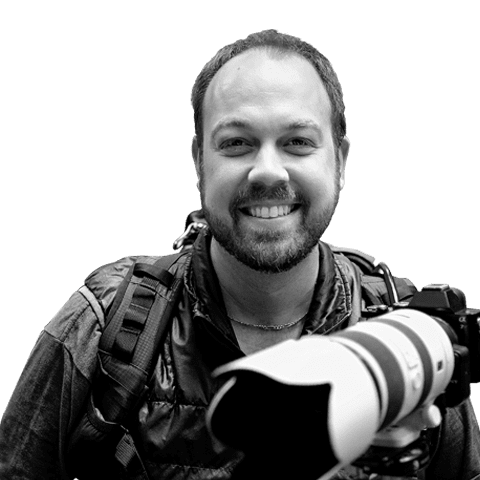It’s a long way from Brooklyn to Portland, and in that journey Brian moved from specializing in urban exploration photography to landscape and travel. Some might be surprised to find that he’d never slept in a tent until his late twenties. In the past two years, he says, he’s traveled more than in the entire rest of his life.
Amid all of this transition, Brian learned the ropes of being a creative professional, in part by working for companies such as ON1, Google, and Sony. A visit to his online shop reveals not only the usual ability to order prints but also his own ebooks, preset and texture packs, and photo editing and workflow training materials. He understands the value of having residual income streams as well as equitable, dependable partnerships. According to Brian, one of the most critical partnerships he has is with his storage provider.
"Everyone focuses on the cameras and the lenses," he says, "and it’s, ‘Wow, this has 42 megapixels and that dynamic range and the lens can open up to 1.2!’ And that’s great for getting a solid photo. But no one really focuses too much on what happens after you take the photos and it’s time to store them. That’s possibly even more important than the camera. If you don’t have reliable storage for your photos, you’re done. You can have the most amazing camera in the world, but your shots are still at risk of being corrupted or lost altogether."
Those who follow Brian know of his epic struggle with storage and the methodology that has saved him from repeated disasters. In his blog, he sets out the five things critical for his storage strategy:
1. "I need a scalable storage solution to hold my entire catalog of photos and videos while growing with my needs."
2. "I need to have a storage container that can leverage the fastest possible bus speed of my computer. In this case, it is Thunderbolt 2."
3. "I need my storage container to have failsafes in place to protect it from possible hard drive failures."
4. "I need to have a fast and reliable on-site, mirrored backup of my entire photo and video library."
5. "I need to have ready access to a local off-site copy of my library with an incremental backup loss of no longer than two weeks."
He had hardware and a plan, and only the latter saved him from the former. From 2010 to 2014, Brian opened no fewer than 21 support cases with his storage provider and finally reached a breaking point. Calling out for advice from fellow photographers and crowd-sourcing opinions on social media led Brian to explore G-Technology®’s powerful storage solutions. This opened doors and dialog that ultimately landed Brian his own spot on the G-TEAM and, more importantly, a migration of his entire workflow onto G-Technology storage solutions.
Today, Brian’s photography operates along two workflows, one for home and one for travel. For local shoots, he’ll bring his SD cards back to his desk. Working with Chronosync through his Mac Pro®, he backs up all files to a pair of G-Technology 16TB G-SPEED® Studios, one for production and the other for onsite backup. To capture any subsequent changes made during editing and production, a 2:00 AM incremental backup runs between the two G-SPEED Studios every day. Next door, a friendly neighbor with "a gigantic, fireproof, bombproof safe" lets Brian do incremental backups every two weeks to a 16TB G-RAID® in order to prevent against physical catastrophe. For a time, he considered cloud-based backup rather than the G-RAID but finally decided that, if disaster ever struck, "it would take me a year to download all of my photos from the cloud, and that’s not really an option for me."
For travel, Brian has two 500GB G-DRIVE® ev SSD units, each housed in its own ev All-Terrain Case (ATC). He doesn’t store photos on his laptop, preferring instead the superior ruggedness, performance, and convenience of G-Technology portable solutions. As in his home office, one G-DRIVE ev SSD serves as his on-the-road production drive while the other serves as a backup volume. Again, Chronosync helps with before-bed incremental updates. During the day, he leaves the backup drive in a hotel safe or, if necessary in less developed regions, locked in a bag that is in turn locked and tethered to a pipe.
Once he returns home, Brian slips his G-DRIVE ev SSDs out of their ATCs and into the G-DOCK ev® enclosure on his desk. Through this, he copies the ev SSD data over to the G-SPEED Studios. He notes that one of the several reasons he enjoys the G-DOCK ev is the greater ease he has in doing volume comparisons to ensure that no data has been corrupted. Conceding his own touch ofobsessiveness, he also likes "the elegance" of daisy-chaining his G-DOCK and G-SPEED STUDIOs, having only one data cable and one system port tied up. Only after the neighboring G-RAID completes its incremental backup will Brian clear off the travel drives for reuse.
For Brian, this storage workflow is critical to the viability of his business. Like so many other professionals, he’s seen days in which his entire production volume crumbled and only that backup saved his clients’ data. He notes with grave emphasis, "If I didn’t have backups, I’d be in seriously bad shape." Reliable storage lets him sleep at night and protects all of his work amassed from years of irreproducible toil.
"I recently saw this article where they posted 19 reasons why photographers fail," he adds. "At number three, they had ‘you treat yourself as a photographer first and not a businessperson.’ That’s wrong. That should have been number one."





